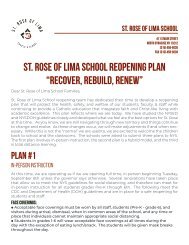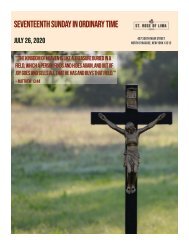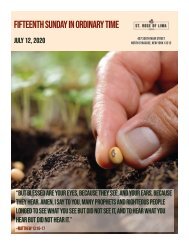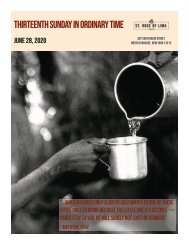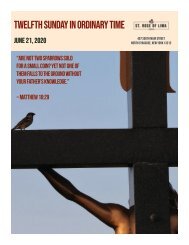Fourteenth Sunday in Ordinary Time
"When we truly understand that we have put on Christ, our burdens can become much lighter. It is odd that so many Christians look like they are carrying the weight of the world on their shoulders. Wouldn’t it be wonderful if those weights could be lifted and joy experienced!" ~ An excerpt from this week's LPI Gospel reflection
"When we truly understand that we have put on Christ, our burdens can become much lighter. It is odd that so many Christians look like they are carrying the weight of the world on their shoulders. Wouldn’t it be wonderful if those weights could be lifted and joy experienced!"
~ An excerpt from this week's LPI Gospel reflection
Create successful ePaper yourself
Turn your PDF publications into a flip-book with our unique Google optimized e-Paper software.
July 5, 2020 | Page 7<br />
Sa<strong>in</strong>t of the Week<br />
St. Benedict<br />
(480 – 547)<br />
Benedict of Nursia was a monk and abbot who lived <strong>in</strong> the 5th and<br />
6th century AD. He founded several monasteries and wrote a rule<br />
for monasteries which became fundamental for Western Monasticism.<br />
The Catholic Church venerates him as Patron of Europe.<br />
The pr<strong>in</strong>cipal source for Benedict’s life are the Four Books of<br />
Dialogues which Pope Gregory the Great wrote <strong>in</strong> 593/594 AD.<br />
Book Two is entirely devoted to Benedict, show<strong>in</strong>g his personal<br />
spiritual journey and portray<strong>in</strong>g him as a great ascetic, a prophetic leader of monks and founder of monasteries, as author of a rule and miracle-worker.<br />
The text stands <strong>in</strong> a tradition of hagiographic writ<strong>in</strong>gs and is more <strong>in</strong>terested <strong>in</strong> spiritual facts than <strong>in</strong> <strong>in</strong> biographical detail. A special emphasis is placed<br />
on scenes which echo those of great biblical figures, especially of the prophets ElijaH and Elisha, Who We heard about <strong>in</strong> last week’s first read<strong>in</strong>g.<br />
The general outl<strong>in</strong>e of Benedict’s life as given by Pope Gregory has later been enhanced with details taken from local traditions and with educated guesses on<br />
dates which have become part of an accepted traditional chronology: Benedict and his tw<strong>in</strong> sister Scholastica were born <strong>in</strong>to a Christian noble family <strong>in</strong> Nursia<br />
(modern day Norcia), <strong>in</strong> 480 AD. Benedict went to Rome for his studies. He grew weary of life <strong>in</strong> Rome, hav<strong>in</strong>g found his companions’ lives dissolute and immoral,<br />
and his teachers unchristian and corrupt. This led him to abandon his studies <strong>in</strong> Rome to pursue a spiritual life. He left the city with his faithful family nurse<br />
Cirilla accompany<strong>in</strong>g him as far as Enfide (modern Affile). Benedict spent time liv<strong>in</strong>g as a hermit, <strong>in</strong> spiritual isolation <strong>in</strong> a cave later identified as the Sacro<br />
Speco at Subiaco. The monks of a nearby monastery asked Benedict, who was by then a well known holy man, to become their new abbot. His <strong>in</strong>sistence on proper<br />
monastic discipl<strong>in</strong>e, however, brought him <strong>in</strong>to conflict with the community who attempted to poison him. Benedict miraculously escaped harm and returned<br />
to his cave. Later he established 12 monasteries near Subiaco and resided <strong>in</strong> the 13th as abbot. Around the year 529 AD he left Subiaco with his most devoted<br />
disciples for Cass<strong>in</strong>o and founded a monastery <strong>in</strong> the ancient pagan acropolis on the hill overlook<strong>in</strong>g the town. Here he wrote the supremely <strong>in</strong>fluential Rule<br />
of Monasteries and served as the new monastery’s first abbot until his death on a 21st March, traditionally thought to have been <strong>in</strong> 547. He was followed soon<br />
afterwards by his sister Scholastica who, unusually, was buried <strong>in</strong> the same tomb.<br />
Pope Gregory’s Dialogues made Benedict one of the most popular sa<strong>in</strong>ts of the Italian pen<strong>in</strong>sula. Thousands of monasteries which eventually came to follow his<br />
Rule also spread the veneration of this sa<strong>in</strong>t.<br />
Accord<strong>in</strong>g to a well attested tradition, the relics of St Benedict were transferred to the monastery of Fleury (France) <strong>in</strong> 672. This transfer is liturgically<br />
celebrated on the 11th of July. The transfer of the relics is disputed at Montecass<strong>in</strong>o however, where, after the bombardment of the monastery dur<strong>in</strong>g World<br />
War II, the jo<strong>in</strong>t tomb of Benedict and his sister was uncovered, apparently confirm<strong>in</strong>g the account of their burials by Pope Gregory.<br />
In 1947 Pope Pius XII recognized St<br />
Benedict as the “Father of Europe.” In<br />
1964 Pope Paul VI declared him “Patron<br />
of Europe.” Pope John Paul II enlarged<br />
the group of Patrons of Europe, add<strong>in</strong>g<br />
Cyril and Methodius <strong>in</strong> 1980, and<br />
Cather<strong>in</strong>e of Siena, Bridget of Sweden<br />
and Edith Ste<strong>in</strong> <strong>in</strong> 2000.<br />
The feast of St Benedict is now generally<br />
held on July 11, but Benedict<strong>in</strong>e monasteries<br />
also ma<strong>in</strong>ta<strong>in</strong> a celebration on March 21.<br />
From The Order of St. Benedict<br />
Mount Saviour Monastery (left) and Abbey of the Genesee are each Benedict<strong>in</strong>e monasteries <strong>in</strong> the<br />
Diocese of Rochester, but with<strong>in</strong> two hours of North Syracuse. Mount Saviour is just outside Elmira<br />
and the Abbey is a bit north of Geneseo.




